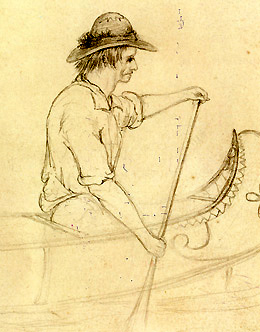In the summer of 1808, Jacques Raphael "Jaco" Finlay (1768-1828) guides five Iroquois trappers from eastern Canada across the Continental Divide. Finlay, a "free hunter" and former and future clerk for the fur-trading North West Company, brings the eastern Indians to trap beaver with him in the firm's newly established Columbia District. Known only by their first names -- Joseph, Pierre, Ignace, Martin, and Jacques -- these men, and those who follow them west, will change the economic and social fabric of the Inland Northwest. After Finlay establishes Spokane House near present-day Spokane in 1810, many of the Iroquois will settle nearby in the Colville Valley.
Iroquois tribesmen had been involved in the fur business ever since French traders entered their homeland around the Great Lakes in the seventeenth century. Their knowledge of fur-bearing animals and their skill with traps and canoes made them indispensable to the trade. In the years that followed, many of them converted to Catholicism and adapted elements of European clothing and cultural ways. As beaver grounds in the East were trapped out, they moved West with the company posts, fanning out in all directions in search of pelts.
When David Thompson (1770-1857) began establishing trading posts west of the Divide in 1807, he and his partners in the North West Company decided to import several Iroquois to hunt beaver and to encourage the Plateau tribes in trapping for the company. The first five recruits crossed the Rockies in the summer of 1808; Thompson’s journal contains a contract with one of the men, written in French and signed with an X. Thompson also listed the items advanced to the five new hunters, which included steel traps and wool blankets as well as fine corduroy trousers, calico shirts, black silk handkerchiefs, and two pounds of soap each.
Jaco Finlay served as their mentor to the trade, tribes, and territory of the Columbia District, and by late fall of 1808 the newcomers had already amassed eight packs (more than 700 pounds) of furs. Jaco and his family escorted their protégés to Kootanae House to deliver their pelts in early November, and Thompson’s clerk James McMillan settled accounts, adding a reward in the form of rum, after which the group "drank and fought the whole night." Next evening, McMillan returned to Jaco's camp for another round of revelry (Thompson, Notebook 23, November 12-13, 1808).
As Thompson and the Nor’Westers added more posts to their trade network during the next four years, the Finlays and their Iroquois compatriots moved south and west along with them, hunting beaver along the Pend Oreille, Flathead, Clark Fork, and Colville rivers. More Iroquois crossed the Divide to work the fresh beaver grounds, and Thompson frequently hired these independent trappers to hunt for him, deliver messages, and help paddle his canoes. When he set off from Kettle Falls in 1811 for his historic trip to the Pacific, two of his crewmen were Charles, an Iroquois who had been working the upper Columbia, and Ignace, one of the original recruits from 1808.
Following Jaco Finlay, many of the Iroquois settled in the Colville Valley, where they married into the local tribes and became an integral part of the social fabric. They continued to run trap lines for the remaining years of the fur trade, supplying a substantial percentage of the pelts that contributed to the profits of the North West and Hudson’s Bay companies’ Western enterprise.

